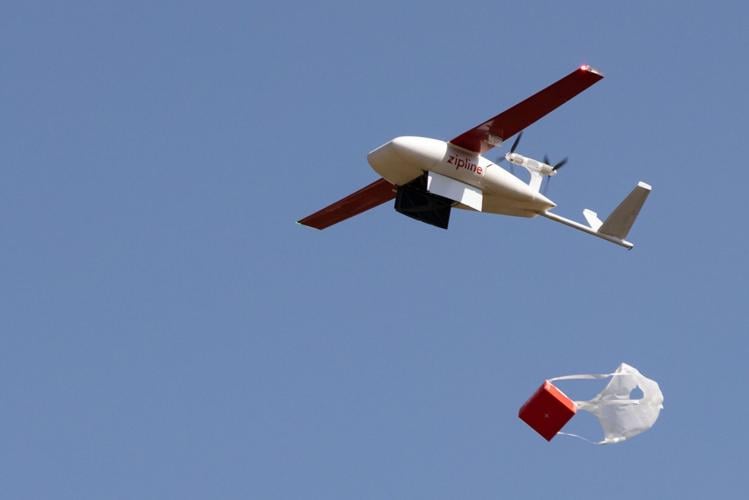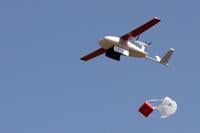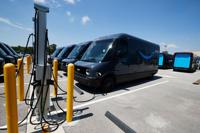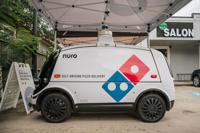
Zipline drones have been delivering medical supplies to hard-to-reach facilities in multiple African countries.
(CNN) �� In recent years, we’ve grown accustomed to the sight of Amazon vans and courier cars bringing packages to our doors. But according to consultancy firm McKinsey, the growth of e-commerce since the Covid pandemic has �� �� the final stage of the delivery process, where parcels are transported from warehouse to customers.
McKinsey estimated that in 2020, were sent globally, a figure that could double by 2030, with last-mile delivery increasingly .
But new innovations in logistics are taking on these challenges and transforming the way we receive packages. Here are five technologies that are shaking up the industry.

Electric Amazon delivery vans charge their batteries at an Amazon facility in Chicago, 2022.
Delivery robots
Delivery robots are on the rise, and have been used by big-name companies such as and .
Since the beginning of the Covid-19 pandemic, demand for service robots has only grown, with worldwide sales , according to the International Federation of Robotics.
In Leeds, UK, box-sized robots maneuver their way along sidewalks to deliver groceries. In partnership with retail chain Co-op, Starship Technologies sends its battery-powered robots to customers�� doorsteps to deliver food and packages �� all managed through its app.
Delivery robots are also helping in areas beyond food service.

Domino's Pizza is one company exploring self-driving delivery vehicles like the one pictured here from July 2021.
In Hong Kong, Rice Robotics, a startup founded in 2019, developed viable for use across many industries including healthcare and hospitality.
Electric delivery vehicles
Emissions from last-mile delivery traffic will increase by 32% by 2030, according to a 2020 World Economic Forum . Delivery giant Amazon co-founded in 2019, making a commitment to achieve net-zero carbon emissions by 2040. In Europe, the company plans to spend on electric vehicles, increasing its fleet of electric delivery vans on the continent to 10,000 by 2025. In the US, Amazon plans to have 100,000 electric delivery vehicles on the road by 2030, in partnership with electric vehicle manufacturer Rivian.
Meanwhile in India, are getting the electric treatment through a company called Altigreen �� while Estonia-based offers a four-wheeled electric cargo bike currently available in several cities including London, Stockholm, and Copenhagen.
Smart parcel lockers
Instead of direct-to-doorstep deliveries, some companies are exploring smart parcel lockers. Belgian startup Bringme built its first lockers in the Balk van Beel apartment complex in Leuven, Belgium in 2012.
Allowing couriers to cut down significantly on the number of repeat deliveries to a single location �� trimming carbon emissions �� it’s billed as an efficient and sustainable solution to the last-mile delivery system.
In addition to being an environmentally friendly alternative to home delivery, smart parcel lockers act as secure storage when online shoppers are unable to receive a package right away.
When Bringme users are ready to collect their package, they receive a QR code through their app. Users then show their QR code to the scanner and proceed to take their package from an unlocked compartment.
Smart lockers can also come tailored to specific needs �� such as the one made by startup , which can adjust temperatures for cold grocery storage, or hot food delivery.
Autonomous vehicles
Bigger than delivery robots, with much more room for cargo, self-driving vehicles could play an important role in home deliveries in coming years.
Last year, Uber Eats signed a deal with Nuro, beginning with trialing its driverless delivery pods in Mountain View, California, and Houston, Texas.
Nuro was founded in 2019 by two former principal engineers for Google’s self-driving program, and its eponymous third-generation vehicle can fit nearly .
Modular inserts with both heating and cooling capabilities allow for transport of a range of goods. The fully battery-powered and emission-free vehicle also uses 100% renewable electricity from wind farms in Texas, according to the company.
Delivery drones
While Amazon Prime Air has struggled to get full FAA approval in the US, other drone delivery services have already taken flight. In early 2022, more than 2,000 were occurring every day worldwide, according to McKinsey, and that number has only grown since.
In Rwanda, central Africa, US-based startup Zipline has been making in the health care sector since 2016. Meanwhile in Ireland, Manna Aero has been delivering everything from groceries to orders from small businesses, having completed over 100,000 drone deliveries across the country (with plans to expand further into Europe and the US). Through its app, customers order goods which stores then pack and send by drone.
A Carnegie Melon University found that of the many last-mile delivery methods, very small quadcopter drones (second only to e-cargo bikes) were among the most efficient in terms of energy consumption and CO2 emissions �� up to 94% lower energy consumption per package.
The-CNN-Wire
�� & © 2023 Cable News Network, Inc., a Warner Bros. Discovery Company. All rights reserved.


















